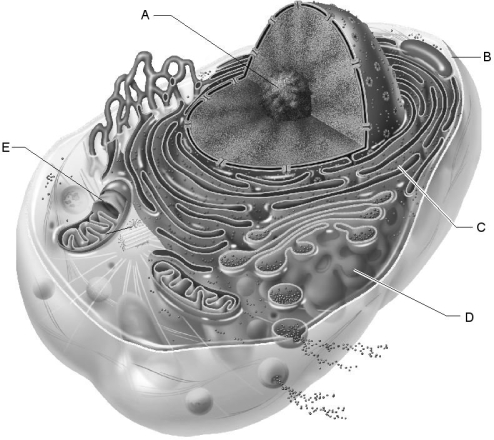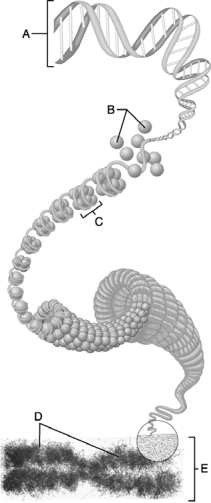A) form the aster.
B) re-form the nuclear envelope.
C) pull the chromosomes to opposite poles of the cell.
D) pull together the replicated chromosomal strands.
Correct Answer

verified
Correct Answer
verified
Multiple Choice
This organelle produces ATP molecules.
A) Golgi apparatus
B) lysosome
C) rough endoplasmic reticulum
D) mitochondria
E) peroxisome
Correct Answer

verified
Correct Answer
verified
True/False
Extended chromatin is tightly wound around histones.
Correct Answer

verified
Correct Answer
verified
Multiple Choice
Functions of the Golgi apparatus include all of the following except
A) plasma membrane formation.
B) synthesis of lysosomes.
C) production of secretory granules.
D) DNA replication.
Correct Answer

verified
Correct Answer
verified
True/False
Peroxisomes are important in detoxification of a number of toxic substances, for instance, hydrogen peroxide.
Correct Answer

verified
Correct Answer
verified
Multiple Choice
Dyneins and kinesins are motor proteins that
A) resist pulling forces that are placed on cells.
B) move organelles along microtubules through the cytoplasm.
C) enable a cell to send out and retract extensions called pseudopods.
D) are molecular components of telomeres.
Correct Answer

verified
Correct Answer
verified
Multiple Choice
Which type of endocytosis ingests the most specific type of molecule?
A) receptor-mediated endocytosis
B) pinocytosis
C) phagocytosis
D) fluid-phase endocytosis
Correct Answer

verified
Correct Answer
verified
Multiple Choice
 Figure 2.1
Use the diagram above to answer the following questions.
-Which letter indicates the nucleolus?
Figure 2.1
Use the diagram above to answer the following questions.
-Which letter indicates the nucleolus?
A) A
B) B
C) C
D) D
E) E
Correct Answer

verified
Correct Answer
verified
Multiple Choice
Phospholipids of the plasma membrane are arranged
A) as a bilayer with their nonpolar tails sandwiched between the polar heads.
B) around a central layer of cholesterol.
C) in a single layer with polar heads facing outwards.
D) as a bilayer with their polar heads sandwiched between the nonpolar tails.
Correct Answer

verified
Correct Answer
verified
Multiple Choice
Which of the following statements about the rough endoplasmic reticulum is false?
A) It consists of stacked envelopes called cisternae.
B) It makes the integral proteins of the cell membrane.
C) It stores lipids as inclusions.
D) It makes the digestive enzymes contained in the lysosomes.
Correct Answer

verified
Correct Answer
verified
Multiple Choice
 Figure 2.1
Use the diagram above to answer the following questions.
-Which letter indicates the rough endoplasmic reticulum?
Figure 2.1
Use the diagram above to answer the following questions.
-Which letter indicates the rough endoplasmic reticulum?
A) A
B) B
C) C
D) D
E) E
Correct Answer

verified
Correct Answer
verified
Multiple Choice
 Figure 2.2
Use the diagram above to answer the following questions.
-Which letter indicates the chromatid?
Figure 2.2
Use the diagram above to answer the following questions.
-Which letter indicates the chromatid?
A) A
B) B
C) C
D) D
E) E
Correct Answer

verified
Correct Answer
verified
Multiple Choice
The process of cellular aging may involve all of the following except
A) decreased production of lysosomes.
B) accumulated damage by free radicals.
C) progressive shortening of telomeres.
D) excessive metabolic rate.
Correct Answer

verified
Correct Answer
verified
Short Answer
What would extended chromatin wrapped around a group of eight histones be called?
Correct Answer

verified
Correct Answer
verified
Multiple Choice
Peroxisomes
A) synthesize proteins for use outside the cell.
B) are the toxic waste removal system of the cell.
C) contain some of the code necessary for their own duplication.
D) are involved in the production of ATP.
Correct Answer

verified
Correct Answer
verified
Multiple Choice
Materials that are to be exocytosed by cells are enclosed in vesicles synthesized by the
A) mitochondrion.
B) nucleosome.
C) Golgi apparatus.
D) ribosome.
Correct Answer

verified
Correct Answer
verified
Multiple Choice
In chromatin, the DNA molecule wraps around proteins called
A) integral protein.
B) codons.
C) nucleotides.
D) histones.
Correct Answer

verified
Correct Answer
verified
Essay
Describe the mitochondria.
Correct Answer

verified
These are long, thin organelles, that ha...View Answer
Show Answer
Correct Answer
verified
View Answer
True/False
During the G1 phase, DNA is replicated in the cytoplasm.
Correct Answer

verified
Correct Answer
verified
Short Answer
This is the name for the currently held theory describing the plasma membrane structure.
Correct Answer

verified
Correct Answer
verified
Showing 41 - 60 of 110
Related Exams